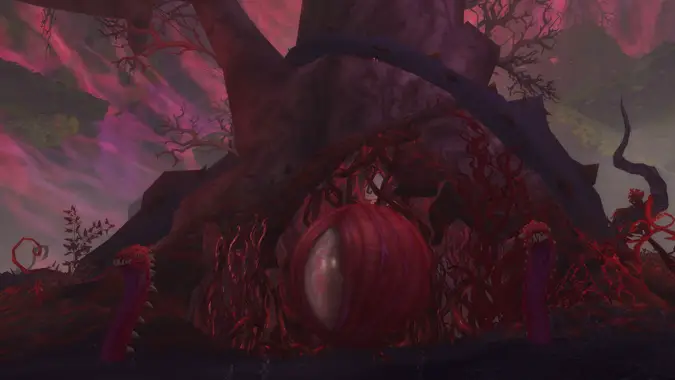Know Your Lore, Tinfoil Hat Edition: Whispers of the Old Gods

Both the Sundering and the Shattering were large-scale natural disasters for the shell that surrounds Azeroth’s world-soul. Yet even though that shell was weakened and the Old Gods managed to extend their influence beyond their prisons, that world-soul apparently remains intact and uncorrupted. However, the residents of Azeroth didn’t manage to escape the touch of the Old Gods. The Curse of Flesh tainted the very ecology of the planet, affecting the majority of Azeroth’s native species.
But despite it all, we mortals of Azeroth have prevailed. We dealt with C’thun, we dealt with Yogg Saron, and we even put the Sha – maddened remnants of Y’shaarj – in their place. …or did we? Legion has seen a quiet resurgence of enemies that by all rights should be dead. But are the Old Gods really dead? Can they even be killed?
Today’s Know Your Lore is a Tinfoil Hat edition. The following contains speculation based on known material. These speculations are merely theories and shouldn’t be taken as fact or official lore.

Emerald Nightmare
In Val’sharah, we’ve seen the return of the Emerald Nightmare, theoretically contained and locked away in the novel Stormrage. The Emerald Dream was originally accessed due to the foolish actions of Fandral Staghelm. In his zeal to rid the world of an unusual saronite problem, he accidentally created a method for Yogg Saron to access the Emerald Dream, opening a direct gateway for the influence of the Old Gods.
Their main pawn in the game was Xavius, a former Highborne who died at Malfurion’s hand in the War of the Ancients, only to be resurrected and given new form by Sargeras himself. As a satyr, Xavius continued to carry out Sargeras’s demands, spreading the curse of the satyr to his Highborne brethren, and confronting Malfurion Stormrage. But Stormrage beat him a second time, and this time, he grew a tree around the satyr, one that absorbed both his energy and body. Xavius was presumably defeated, again.
That didn’t turn out to be the case, and the next time Xavius showed up, he had new masters to work for. Ten thousand years later, the Emerald Nightmare surged forth, trapping Malfurion within it. Once again, the druid behind it all was Fandral Staghelm. This time, he was influenced by what he thought was his dead son, Valstann. Not only did he keep Malfurion trapped in the Emerald Dream through doses of Morrowgrain, he also corrupted Teldrassil itself, by grafting a branch of the tree that held Xavius’ spirit to the World Tree. Again, he was thought to be defeated at the end of the Nightmare War and again, he resurfaced in Legion, once more at the helm of the Emerald Nightmare.
Except that he wasn’t really the one in charge of the Nightmare at all. No, that distinction fell to another Old God: N’Zoth.

N’Zoth
We’ve never dealt with N’Zoth directly, and for good reason. The Old God was essentially the counterpart of Ysera. Ysera slept to keep watch over the Emerald Dream. N’Zoth sleeps to apparently keep watch over the Nightmare, and foster the Dream’s corruption. In the days of the Black Empire, before the Titan’s arrival, N’Zoth was constantly at war with C’thun and Yogg-Saron. But he was considered the weakest of the Old Gods. He was the first to be imprisoned after Y’Shaarj’s death.
Perhaps that’s why N’Zoth either took, or was given, the task of corrupting the Emerald Dream. It’s implied that N’Zoth sleeps deep beneath Azeroth’s oceans. This makes him the likely culprit for the transformation of Queen Azshara and her Highborne into the naga, as well as Xavius’s continued corruption. And in the Emerald Nightmare raid, shadow priests get an interesting whisper when they reach the Il’gynoth encounter. “It appears the prison of N’Zoth is not as strong as it once was. What you see is a tiny growth of the behemoth that may yet consume your world.”
Il’gynoth also has a series of whispers for would-be heroes…and the implications they hold are pretty disturbing. One line in particular stands out above the rest: “At the hour of her third death, she will usher in our coming.” This line has been up for a considerable amount of debate – who is “she?” What is this third death Il’gynoth speaks of? Whose coming will that death usher in?

Azeroth
There’s one other major piece of information we’ve gotten from Legion. The very nature of Azeroth’s existence, the world-soul that dwells within the planet was finally revealed. And it’s a she – according to Magni Bronzebeard, who now acts as a Speaker for the world-soul. It was through Magni, and the world-soul he speaks to, that we discovered the existence of the Pillars of Creation. If Azeroth is a she, could the third death be referring to the world-soul itself?
It could be argued…except that the world-soul is apparently still intact and still very much alive. Or so we think. Here’s the interesting part about the Old Gods, something we’ve been told since the reveal of the Tribunal of Ages in Wrath: We can’t kill them. The Titans pretty much directly stated that killing the Old Gods would “result in loss of host.” Azeroth would be destroyed.
Except what if “loss of host” didn’t actually mean the planet’s destruction? Brann leapt to that conclusion, and the Tribunal didn’t correct him. But the Tribunal wasn’t necessarily accurate. The Tribunal of Ages was in fact created by Loken. It was a means to cover for his betrayal of the other Titan watchers stationed at Ulduar. Loken was under the influence of Yogg-Saron – another pawn of the Old Gods.
So, following that logic…what if the “third death” referenced in that whisper isn’t actually talking about “her” death at all?

Sacrifice
What did the Titans learn, after the death of Y’shaarj? Obviously, that death ripped open a wound that left the world-soul weakened. But what it also did – what we discovered in Pandaria – was release the “last, terrible breath” of the Old God, which then manifested as the Sha. These malevolent beings were born and fed off of the emotions of those around them. Anger, fear, hatred, violence, doubt, despair, and pride – all had tainted and corrupted a continent that was carefully sealed away from the rest of the world.
This is what happens when you kill an Old God. It doesn’t die – its essence simply seeps deeper into the world, infecting it further. Now ask yourselves: What have we done? When we “killed” C’thun, we didn’t see the world end. When we “killed” Yogg-Saron, we didn’t see the world end. And when both of these Old Gods continued to spread their influence, we leapt to the conclusion that we couldn’t kill them at all – a conclusion backed up by a Tribunal that was in and of itself, a lie.
Two Old Gods. Two deaths. One Old God remains – and if we kill that Old God, it’s entirely possible Azeroth will suffer a “loss of host.” Not the destruction of the world – the complete corruption of it. In our zeal to rid the world of what corrupts it, we may very well have been the driving force for its destruction. For as Il’gynoth states in the Emerald Nightmare, “Her heart is a crater, and we have filled it.” Whether or not we choose to believe these whispers, or how they are interpreted, one thing is certain – a reckoning is coming, and it will make the Burning Legion pale in comparison.
Next week, we’ll look at whispers from a different source: A peculiar weapon whose origins lie with the Old Gods, though it rests in mortal hands.
Please consider supporting our Patreon!
Join the Discussion
Blizzard Watch is a safe space for all readers. By leaving comments on this site you agree to follow our commenting and community guidelines.
 @Shadesogrey
@Shadesogrey



